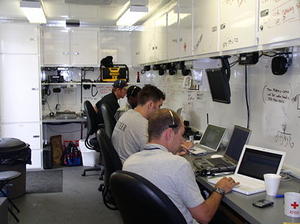FCC asks for public comments on public safety band for first responders
The U.S. government wanted to use a portion of the 700 MHz band — which became available after the June 2009 transition from analog to digital TV — for public safety communication; the government hoped that large wireless providers would pay $1.3 billion for that portion of the band, but the highest bid came in at $472 million; the FCC is trying again

Active mobile communications center // Source: modot.org
Federal regulators are trying again to allocate unused wireless frequency spectrum for a national public safety broadband network, and they want stakeholder input on how to establish a reliable, secure, and interoperable system (see “FCC’s new public safety proposal receives mixed response, 2 March 2010 HSNW). The Federal Communications Commission (FCC) issued a public notice (.pdf) on the matter Tuesday, comments are due with the commission 17 June.
Joseph Straw writes in Security Management that most Americans will recall the highly publicized June 2009 transition from analog television broadcast signals to digital. The switch to digital signals, which require far less frequency spectrum than analog, opened up large swaths of the 700 MHz band. The FCC held a series of auctions to sell licenses for five separate segments of freed-up spectrum, four for commercial broadband use, and a fifth called the Block D auction. The company that bought rights to the Block D spectrum would be expected to fund construction of a nationwide wireless infrastructure to support Internet protocol (IP) networking among first responders (for more on public safety band and communications interoperability, see “Communicating to Save Lives” from the May 2009 issue of Security Management).
Straw notes that the vast majority of U.S. public safety voice radio transmission is spread across the VHF and UHF bands between 136 and 520 MHz and in the 800 MHz band. Availability of the 700 MHz band would not change that. The new bandwidth could, however, be used for any data, including voice-over-IP and a related interoperability technology called radio-over-wireless broadband (ROW-B).
Large wireless providers gobbled up four of the five spectrum blocks at auction, but Block D failed to command the required minimum bid of $1.3 billion, drawing a high bid of $472 million. Analysts blamed the struggling economy and doubts about the profitability of the venture.
Given the pressing desire for dedicated wireless access in the public safety community, the FCC started granting access to parts of the 700 MHz band for public safety use on a case-by-case basis, including a DHS Science and Technology Directorate pilot that tested ROW-B in Washington, D.C.
Last week the FCC issued an order granting “conditional waivers” to twenty-one public safety agencies for development of broadband networks in the 700 MHz band. Straw writes that the commission now wants input on the necessary regulation to ensure the functionality of a national system that develops across independent jurisdictions.
The FCC seeks feedback on last year’s National Public Safety Telecommunications Council’s (NPSTC) 700 MHz Public Safety Broadband Task Force Report and Recommendations (.pdf), which offered technical options for establishment of networks and connectivity. The Commission also seeks input on standardization of a “nationwide core” for the system, roaming capability for network devices, and ideal security methods.
